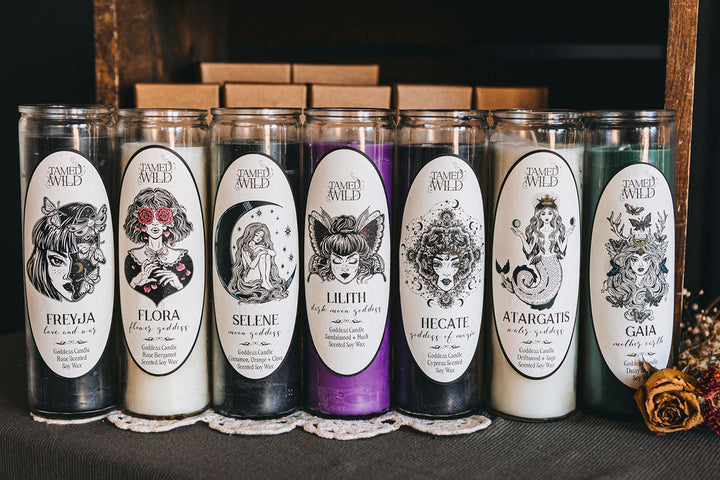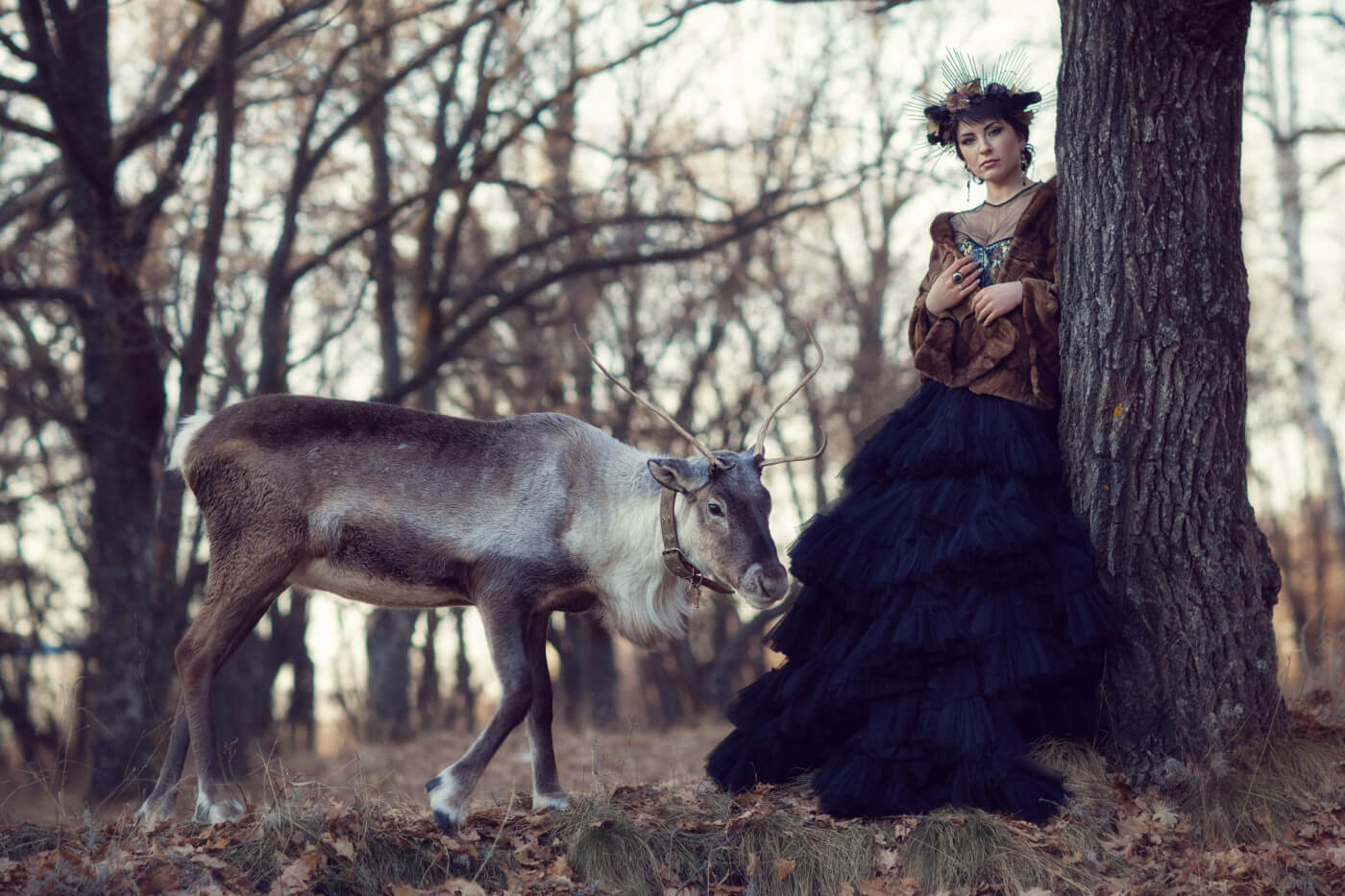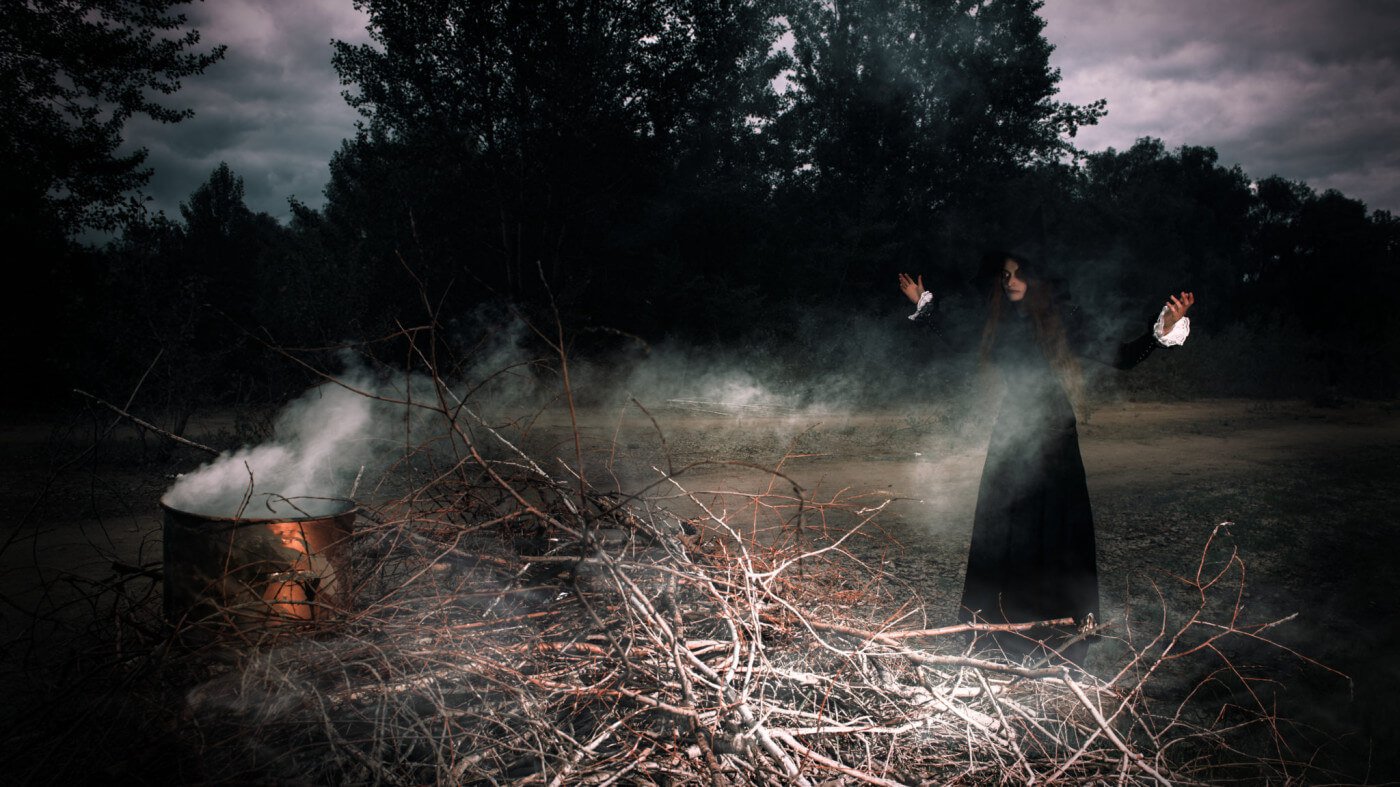Once harvest season has passed and winter’s chill arrives, we say goodbye to the garden and the dirt beneath our nails. We bring nature indoors by swapping out fresh flowers for holly and evergreen trimmings. Soon, shiny baubles hang from the doorways, around our altar, and anywhere that calls for some Yuletide cheer.
But no amount of tinsel and mistletoe can keep us from experiencing the dark months. So instead, when the sun wanes, and the sky is more grey than blue, take a seat and get cozy in one of the dimly lit corners of your mind.
Ask yourself:
Why should I rest, turn inward, and speak with my shadows?
Where in lie the secrets of winter?
Is there someone who knows the way through the storm?
For questions like these, we look to weaving goddesses, the Crones, and the Winter Witches—the ones who have mastered the art of observation, transformation, and quiet wisdom.
Frau Holle: Leader of the Wild Hunt
Associated with snowy days and wintertime plants, Frau Holle appears in Germanic folklore as the helpful grandmother or the forest hag. She lives at the bottom of wells and is an expert at spinning, handicrafts, and hearth magick. When someone visits the old woman, she’ll give them a list of chores, which always includes shaking out the blankets and pillows until the air is thick with feathers. When it’s time for her guests to leave, no matter if they were kind or cruel, Frau Holle rewards them with what they deserve.
In Pagan lore, Frau Holle leads the Wild Hunt alongside a menagerie of animals, faeries, and other wintertime spirits. Honor this Witch by hosting a feast on her sacred day, December 25th.
La Befana: The Friendly Christmas Witch
On the twelfth day of Christmas, La Befana takes to the skies. Unlike Gryla, Skadi, or other fierce witches, La Befana uses her powers to spread cheer.
As the story goes, while on their way to Jesus’s birth, the Three Wise Men stopped by La Befana’s cottage. They invited the grandmother to join them on the final leg of their journey, but she declined. She was in the middle of sweeping and could not be interrupted.
Shortly after the magi left, La Befana realized her mistake. She gathered some gifts, hopped on her broom, and went in search of the divine child. However, in her haste, La Befana forgot to secure the satchel of gifts. One by one, presents fell from the sky and miraculously landed in all the good childrens’ homes.
La Befana’s story is thousands of years old, but even today, she’s loved by many. On the eve of January 6th (known as Epiphany Eve), people leave offerings of tea, coffee, and chocolate for the Italian Christmas Witch. Legend says that La Befana also blesses water left out on her sacred night.
The Fates: Spinning Sisters
Weaving goddesses can be found in nearly any pantheon, season, and stage of life, but they are often associated with cronehood and winter. Maybe that’s because in winter, when things go still and die back, we realize that the nights are good for listening, imagining, and weaving new tales. Maybe it’s because, like the Crone, The Fates answer to no one (not even Zeus). Or maybe it’s because, in the same way that we cannot escape from winter, we cannot hide from destiny.
This claim is true for many reasons, but perhaps the most mystical, intriguing theory is that destiny is not linear. Our life does not exist on a flat plane. It’s a web. And each decision we make adds to the ever-growing tapestry spun by The Fates.
In Greek mythology, the Three Sisters of Fate are known as the Moirai. The youngest is Clotho, who begins spinning the moment a child is born. She collaborates with the middle sister Lachesis, who adds color and detail to our story. When she’s just about finished, the eldest, Atropos, snips the final thread. In doing so, she releases us from this life so we can travel to the next.
Beira: Queen of Winter
According to Scottish lore, Beira’s reign extends from Samhain to Beltane. She is a Dark Goddess, a Crone, and the Queen of Winter.
In Gaelic mythology, Beira is known by another name—the Cailleach. The Cailleach is a divine hag who controls natural disasters, the weather, and storm season. As a giantess with blue skin and one oversized eye, the Cailleach represents true sight, wildness, death, and also rebirth.
Legend says that during winter, while plants go dormant and humans hibernate, Beira hops from one mountain to the next. Caverns form from her footsteps and ice radiates from her magickal staff. But, just like all seasonal deities, Beira’s reign is temporary. In Spring, she leaves her throne in search of the fountain of youth. Her counterpart, Brighid, takes Beira’s seat and rules from Beltane to Samhain.
Demeter: The Mourning Mother
When Demeter mourns the loss of her daughter, humans have no choice but to follow suit.
As an agricultural goddess, we witness Demeter’s despair during the dark months, when trees stand naked and vulnerable. We hear her anguish in the wind when it howls and screams for the lost maiden. And we feel her suffering in our bodies when they ache for warmth, yet the skies remain cloudy and grey.
In winter, Demeter doesn’t rule with joy and optimism as she does in the spring and summer. Instead, when harvest season arrives, and Persephone leaves her mother for the Underworld, Demeter leans into her shadow.
As a Winter Witch, Demeter embodies the struggles that emerge by resisting change. By working with Demeter and other Dark Goddesses, we learn to call back all the pieces of our soul—even if only for a season or two.
For more Winter Witches, check out the stories of Alcyone, Skadi, Gryla, the Snow Maiden, and the Snow Queen.
Goddess Candles (Scented Soy Wax)

$ 250.00
Spell & ritual candles have been used throughout time to focus and direct intent while honoring and evoking the divine. This collection of Goddess Candles were created as a way to honor the feminine and call upon the Goddesses to… read more










